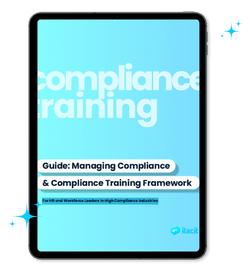So you’ve found your ideal candidate. Great! Whether the recruitment process was long and grueling or short and sweet, finding the right person is just the beginning.
What’s next then? Onboarding.
Effective onboarding in the healthcare industry is crucial to get new hires up to speed quickly, instill organizational values, adhere to compliance and safety protocols, and ensure excellent patient care from day one.
Healthcare workers are a special breed. Their daily work environment can be stressful, busy, and full of surprises. It’s one of those unique fields where precision and compassion must go hand in hand. These professionals not only save lives but also uphold the health standards of our society.
For HR professionals and Learning & Development (L&D) teams, onboarding healthcare workers is a challenging but vital task. They must ensure each new employee is well-trained and fully equipped with the right tools and knowledge from day one. At the same time, they have to continuously adapt to the changing demographics of healthcare workers and their preferences.
In this article, we’ll share the best practices for an effective onboarding process in healthcare. We’ll also explore why it’s crucial for maintaining the high standards of healthcare, how it can reduce employee turnover, and build a stronger, more prepared and engaged workforce
The Importance of Comprehensive Onboarding for New Employees in Healthcare
A comprehensive onboarding program is key to integrating new team members into your healthcare practice effectively.
From the first day, a good onboarding process not only covers essential tasks such as electronic medical records and the use of software and other necessary tools, but also focuses on embedding new staff members into the culture and specific protocols of the health or medical practice.
This approach helps in developing a sense of belonging, ultimately boosting employee retention, and ensuring that each person is aligned with the mission of the healthcare provider.
Steps of Onboarding in Healthcare Organizations
Initial Orientation
The initial orientation should cover healthcare-specific protocols, patient privacy laws such as HIPAA, and the organizational mission, ensuring that employees understand their roles in maintaining compliance and privacy.
Paperwork and Legalities
There’s always paperwork to fill out and file, such as background checks and contracts, which can be time-consuming and difficult to keep track of and file away.
Leveraging digital solutions can streamline the management of forms and legal documents, making the process more efficient and less prone to errors.
Company Culture Introduction
Within healthcare, it’s important to instill a patient-centric and empathy-driven culture from the start, shaping how employees interact with patients and each other.
New hires should have comprehensive training sessions, either in person or digital, as well as support documentation that outline the organizational culture and values.
Job Responsibilities and Employee Training
Clear definitions of job responsibilities and tailored training paths are essential to ensure employees understand their roles and the expectations for their employee journey.

Onboarding the Diverse Roles of Healthcare Workers
Unfortunately, these onboarding steps for healthcare workers aren’t as simple as following a one-size-fits-all procedure. The industry spans a huge range of roles, professions, and working conditions.
Let’s take a look at some of the most common roles in healthcare and offer up a few specific onboarding ideas that you can consider.
Clinical Staff
Onboarding clinical staff involves navigating challenges such as credential verification, adaptation to high-stress environments, and continuous professional development.
Onboarding idea: Incorporate simulation training and crisis management scenarios to help prepare clinical staff for the realities of their roles.
Support and Operational Staff
For support and operational staff – like those handling medical history records – adjusting to shift work and dealing with such a variety of roles may cause significant challenges if they come from outside the healthcare sector.
Onboarding idea: Integrate team-building activities and discussions about shift scheduling during onboarding. This will also boost employee integration while encouraging new hires to get to know the diverse roles of each team member.
Technical and Therapeutic Roles
Roles such as lab technicians and radiology technicians require technical skills and possible compliance training, licensing, and specific certification.
Onboard idea: Along with hands-on experience, the use of virtual reality or augmented reality for training can provide simulated experience in a controlled environment, enhancing skill acquisition without compromising safety.
Social and Mental Health Services
Training for social workers and mental health professionals should include emotional resilience and training for handling ethical dilemmas.
Onboarding idea: Role-playing exercises can be useful in developing emotional intelligence and effective coping mechanisms.
Top 5 Onboarding Best Practices in Healthcare
Effective training is critical for ensuring that healthcare employees are competent, confident, and fully integrated into their roles. Here are five best practices to optimize training for healthcare employees:
- Personalized Training Plans
Cater to the varied experiences and skills of new hires, ensuring each employee receives focused training where needed.
Developing personalized training plans ensures that each employee receives focus in areas where they need the most development, enhancing learning efficiency and job performance.
For example, a nurse with extensive experience in adult care might receive a focused curriculum on pediatric care if they are transitioning into a pediatric department, ensuring they meet specific care standards and regulations pertinent to their new job.
- Blended Learning Techniques
Combine online, face-to-face, and hands-on training methods, accommodating different learning styles and increasing engagement.
Employing blended learning techniques provide a multifaceted approach that caters to different learning styles, increases engagement, and allows for flexibility in learning pacing and styles.
For instance, integrating online tutorials, in-person skill labs, and real-world shadowing with experienced professionals can accelerate proficiency and enhance learning outcomes in certain healthcare environments.
- Regular Feedback and Assessments
Monitor progress and identify any gaps in knowledge or skills, allowing for timely adjustments in the training program.
Implementing regular feedback and systematic assessments can help ensure that all employees are on track to reach their required competency levels.
Take a new pharmacist hire, for example. Periodic skills assessments followed by targeted coaching sessions can help them better understand medication management systems within a hospital.
- Integration of Technology in Training
Digital workplace software and mobile employee apps offer the best way for healthcare workers to access their training material.
This type of platform provides flexible access to training modules, allowing staff to learn and refine skills at their convenience, whether between shifts or in brief downtimes. This on-the-go approach ensures that training can seamlessly integrate into their hectic routines without compromising the quality of education or patient care.
- Mentorship Programs
Pairing new hires with experienced staff can ease the transition into complex healthcare settings and provide ongoing support and mentorship.
This first-hand guidance and support system provides security and helps build confidence as they navigate their new roles. Mentors can offer invaluable insights into patient care, hospital procedures, and professional development.
For instance, pairing a new nurse with a mentor who has a solid track record in patient care excellence can help the new hire adapt more quickly to the demanding and unpredictable environment of a given hospital ward.

The Role of Management in Frontline Employee Onboarding
The involvement of leadership is crucial in mentoring, supporting, and developing a culture of continuous improvement and feedback.
Managers should engage with new hires through regular check-ins and provide supportive feedback to encourage smooth transitions and streamlined integration.
Evaluating the Onboarding Process in Healthcare Organizations
Using Key Performance Indicators (KPIs) such as employee engagement, compliance adherence, and patient satisfaction helps measure the effectiveness of onboarding programs.
Regularly adapting these programs based on feedback from new hires and ongoing assessments will keep them relevant and effective.
Successful Onboarding in Healthcare in 2024
A tailored onboarding process is critical in reducing turnover and improving patient outcomes in healthcare.
Following the best practices we outlined will give your organization a great chance at developing a successful strategy, giving your new hires a truly engaging and comprehensive onboarding experience.
Have questions about optimizing your onboarding process? Contact our iTacit experts today to get personalized advice and solutions.
FAQ
How long should the onboarding process for new healthcare employees typically last?
The duration of the onboarding process can vary significantly based on the complexity of the role and specific requirements, typically ranging from a few weeks to several months.
What are some key performance indicators for evaluating the success of healthcare employee onboarding?
Specific metrics include training completion rates, early turnover statistics, and qualitative feedback from new hires. These indicators help assess the effectiveness of the onboarding process and identify areas for improvement.










